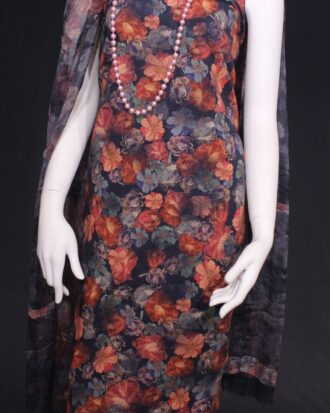
How many times do you repeat your outfit? Or should I ask, how many times CAN you repeat your outfit, before the material wears off or the colors grow fainter? I know, not that long. However, thinking about what happens to the clothes after we throw them out worries me! Does it impact our environment negatively? To find out, we need to delve deeper into the nature of eco-friendly fabrics.
An eco-friendly journey
The fabrics we use every day should be eco-friendly. Eco-friendly fabrics benefit us as they keep the environment out of harm’s way. The production of these fabrics should cause minimum impact on the environment by meeting the terms and conditions of different areas that will be affected by this manufacture. The production, human, and disposal ecology should be borne in mind in terms of clothing and textile. The chemicals used in the production of these materials can act as pollutants and harm the environment.
Production ecology refers to the process of manufacturing textiles and fabrics that should be executed in the least invasive method. Air, noise, and water pollution should be minimized along with managing the waste treatment efficiently. After production comes the utilization of the goods. This is where we should be mindful of human ecology. This refers to the impact of the textile on the user in terms of their health. Any fabric that could cause discomfort to the user or lead to dangerous effects must strictly be avoided. However, the most important aspect of this production lies at the end of the journey of the user and the clothes. What happens after they are done using it?

Here, disposal ecology comes into play.
Disposal ecology refers to how textile waste affects our environment. The reason sustainable textile is important is because while it should serve human needs, we need to be mindful of preserving the environment as well, not just for the present but for the future generations as well. We can categorize fibers into two categories – fibers we like and fibers we dislike! The fibers we “like” fulfill the criteria that categorize these fibers as eco-friendly. For example, made of wastes, no soil erosion, low energy need, and biodegradable. In simple words, eco-friendly textile refers to manufacturing that excludes the use of harmful chemicals and pesticides. These properties have the least negative effect on the environment.
Under fibers we like, plant-based fibers are most common
There are plant-based fabrics such as hemp, linen, bamboo that are eco-friendly as they are disease-free. Linen is a natural fiber that requires fewer resources as compared to polyester and cotton as well. It stalks from the flax plant and requires lower energy, lesser water, and the use of pesticides. Linen is considered to be a sustainable material as the plant it stems from can grow in poor soil not used for agriculture and has great carbon absorption capacity.
In addition to linen, hemp is also a sustainable fiber. It stems from a plant that shares the same name with an incredible growth rate. It requires even lesser energy and water and pesticides. Not only is it less invasive, but it is also beneficial for the soil! One of the important features of this fiber is how for years, it can be cultivated in the same place which means reduced exhaustion. The properties of linen and hemp are similar hence, they are both considered eco-friendly.
Moving on
Many industries also use bamboo as a sustainable fiber. The properties of bamboo plantation are very beneficial for the environment. They grow easily and rapidly; they require NO fertilizers or pesticides. More so, they improve the soil quality, reduce erosion, and rebuild the eroded soil as well. While they benefit the soil, they also reduce greenhouse gases, contributing to keeping global warming under control. Most importantly, they are completely biodegradable! Bamboo linen is 100% eco-friendly in nature.
Different countries are realizing the importance of eco-friendly and organic textile production. Many modifications are being considered to make the production and properties of the fiber eco-friendly. Originally manufactured cotton is now manufactured as organic cotton which keeps us and our environment safe. Growing this cotton not only improves the soil quality but also excludes any form of pollution. It does not harm or pollute the groundwater, surface water, or the air! How COOL is that?

Why is there a growing need to be kinder to our environment?
Firstly, using pesticides and chemicals invade the drinking water and groundwater. It harms us as well as aquatic life. Hence, organic and eco-friendly fibers are better as chemicals and pesticides are not used. An important question now arises. Why is biodegradability an important factor to weigh in while making eco-friendly fibers? The answer is simple. Non-biodegradable fibers lead to POLLUTION! As they can last for years, it can cause clogging of water bodies and the piled up waste can pollute the land. It is a TOXIC practice for the environment and unsustainable for future generations. More so, some synthetic fibers on degrading release harmful toxins that put the environment in grave danger.
We need to be kinder to our environment
If we don’t take care of our mother nature, who will? Some of the organic fibers are less irritable as well. It is a win-win situation! We can pamper ourselves and the environment at the same time. Our skin can enjoy softer and comfortable fabrics while nature can enjoy cleaner ecosystems and live longer! Isn’t it worth it? Eco-friendly clothing should be the NEW normal.
About the author

Tarasha is a 3rd-year undergraduate student pursuing child psychology. She loves to volunteer for social work concerning animals and children. Additionally, she enjoys participating in environmental activities actively, since the Earth is all we have in common and we are all responsible for its well-being.
See what all is on sale !
-
 Floral Embroidery on Cotton CambricOriginal price was: ₹550.00.₹425.00Current price is: ₹425.00.
Floral Embroidery on Cotton CambricOriginal price was: ₹550.00.₹425.00Current price is: ₹425.00. -
 Floral Print on Swiss CottonOriginal price was: ₹2,850.00.₹2,450.00Current price is: ₹2,450.00.
Floral Print on Swiss CottonOriginal price was: ₹2,850.00.₹2,450.00Current price is: ₹2,450.00. -
 Rose Vine Print on Swiss CottonOriginal price was: ₹2,850.00.₹2,450.00Current price is: ₹2,450.00.
Rose Vine Print on Swiss CottonOriginal price was: ₹2,850.00.₹2,450.00Current price is: ₹2,450.00. -
 Small Floral Print on Swiss CottonOriginal price was: ₹2,850.00.₹2,450.00Current price is: ₹2,450.00.
Small Floral Print on Swiss CottonOriginal price was: ₹2,850.00.₹2,450.00Current price is: ₹2,450.00. -
 All Over Floral Print on Swiss CottonOriginal price was: ₹2,850.00.₹2,450.00Current price is: ₹2,450.00.
All Over Floral Print on Swiss CottonOriginal price was: ₹2,850.00.₹2,450.00Current price is: ₹2,450.00. -
 Nature Inspired Abstract Print on Swiss CottonOriginal price was: ₹2,850.00.₹2,450.00Current price is: ₹2,450.00.
Nature Inspired Abstract Print on Swiss CottonOriginal price was: ₹2,850.00.₹2,450.00Current price is: ₹2,450.00. -
 Pure Silk Tie-DyeOriginal price was: ₹1,250.00.₹950.00Current price is: ₹950.00.
Pure Silk Tie-DyeOriginal price was: ₹1,250.00.₹950.00Current price is: ₹950.00. -
 Shiburi Tye-Dye on Pure SilkOriginal price was: ₹1,250.00.₹950.00Current price is: ₹950.00.
Shiburi Tye-Dye on Pure SilkOriginal price was: ₹1,250.00.₹950.00Current price is: ₹950.00.

















